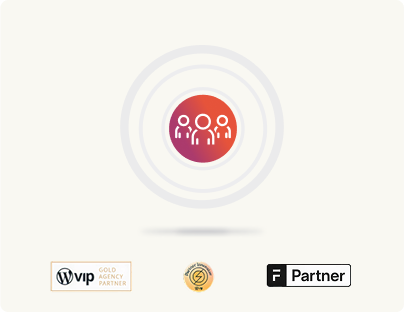The multi-brand enterprise guide to user management in WordPress
Managing users across dozens of websites is rarely just a technical problem, it’s operational and strategic. Multi-brand enterprises, in particular, need a scalable way to orchestrate access, enforce policies, and reduce the manual overhead that typically comes with fragmented WordPress setups. This is where WordPress Multisite steps in, not just as a feature, but as a framework for centralized, controlled, and flexible user management.
In this guide, we’ll explore how user roles, permissions, onboarding, and automation can be tailored to meet the needs of different industries, media, SaaS, retail, and non-profit—and how WordPress Multisite makes this possible.
Why traditional WordPress user management breaks at scale
Imagine managing 30+ sites, each for a different region, brand, or department. You’d have to:
- Add and remove users manually on every install
- Recreate roles across each site individually
- Maintain consistency in who has access to what
- Monitor user behavior separately across each instance
This gets chaotic fast. Mistakes are inevitable. Governance becomes difficult. Security risks creep in.
What enterprises need is:
- Central control, without sacrificing local flexibility
- Standardized role hierarchies and access policies
- Bulk actions for onboarding and offboarding
- Shared access with granular control
- Clean audit trails
WordPress Multisite offers exactly that. Let’s look at how.
Understanding roles in WordPress multisite
In a Multisite network, all users exist at the network level, but their roles are site-specific. This means the same user can be:
- An Administrator on one site
- An Editor on another
- A Subscriber on a third
Super Admins sit above all, they manage the network itself: all users, plugins, themes, and sites.
Example: A global automotive brand uses WordPress Multisite to power regional dealership sites. Each local team gets Administrator rights on their regional site. The central platform team acts as Super Admins, managing plugin updates, security, and brand consistency across all subsites.
Industry-specific role implementations
Different industries operate with different team structures, workflows, and user needs. So naturally, the way they manage access across a WordPress Multisite network varies too. In this section, we’ll break down how user roles and permissions are typically applied across verticals, from publishing and SaaS to retail and nonprofits, and what best practices look like for each use case.
Digital publishing & media: Where editorial velocity depends on access
No industry feels the pressure of daily content publishing quite like digital media. You’re juggling a network of editorial brands, each with its own audience, editorial guidelines, and team structure but often working on the same WordPress infrastructure. The brand teams need to move fast. Editors want independence. Contributors come and go. And the central digital team? They want control without becoming a bottleneck.
This is where things start to fray. Because while WordPress Multisite can technically support all these brand sites under one roof, the real challenge is managing who gets to do what, where, and how fast.
What we’ve found is that publishing organizations need a governance model that mirrors their editorial structure. Lead editors get admin access—but only for their brand. Section editors get granular control. Contributors are brought in and removed automatically. Shared design or video teams are given scoped access across all brands, but only to the assets or pages they work on.
Common roles and access patterns in digital publishing
To keep editorial momentum high without losing oversight, publishing teams rely on these structured, role-based access patterns tailored to fast-paced newsroom workflows.
Guest contributors
Freelancers or external columnists often need temporary access to specific subsites. These profiles typically allow post submission, but not publishing, and can be time-bound or auto-removed after project completion.
Subscriber profiles
Many publishing houses offer gated content. Subscriber roles enable access to paywalled or premium content while restricting backend visibility. These accounts require seamless login flows and often need to integrate with external CRM or membership platforms.
Shared functional teams
Designers, analytics teams, or SEO specialists working across multiple brands need backend visibility and editing rights—but not admin-level access. In practice, this often means assigning a custom role that spans sites and limits scope.
QA, staging, and vendor access
Internal QA teams or third-party vendors might need momentary access to review site changes. These profiles benefit from automation—roles that expire after 7 days or get removed post-deployment.
But even with these structures, editorial organizations often scale quickly or pivot in real-time. A breaking news vertical gets launched. A new podcast brand needs a landing page by Friday. You can’t build a process that assumes every new subsite needs a manual setup. Provisioning must be automated, scoped roles should be reusable, and no one should be guessing who has access to what.
In publishing, velocity is everything. But the only way to move fast without compromising control is by aligning access with editorial workflows from day one.
Large product & SaaS: Why cross-functional access isn’t optional
For product companies, especially SaaS platforms, your website isn’t just marketing. It’s onboarding. It’s documentation. It’s the knowledge base. The dashboard. Sometimes, it’s the entire product.
In this world, user management gets complicated fast. You’ve got product teams launching feature sites, marketing teams running demand gen microsites, support teams managing help content, and engineering teams testing across staging environments. Add in legal, compliance, and vendor integrations—and suddenly, what looked like a content stack is really a web of tightly coupled experiences.
Multisite helps by giving structure. But structure alone isn’t enough. Without the right access design, teams get blocked. Campaigns slow down. Features miss deadlines. Worse, security gaps appear where you least expect them.
Common roles and access patterns in SaaS organizations
These role setups reflect how SaaS companies function with cross-functional collaboration, sandboxing, and strict access tiers built into their workflow.
Sandbox & trial users
SaaS businesses often want prospective users to ‘try before they buy.’ Sandbox environments or demo sites can be spun up as subsites where trial users are granted tightly scoped access. These users may need time-limited credentials and automation to wipe content after inactivity.
Cross-functional teams
Product managers, designers, marketers, and customer success all need to collaborate on experience layers. That means custom roles—like “Content Editor + Feature Flags” or “PM-Only Dashboard Access”—that don’t exist out of the box, but absolutely matter.
Contracted developers & agencies
Whether it’s a dev shop building a microsite or a security firm doing an audit, SaaS companies need ways to grant temporary access—with full observability and auto-expiry. This keeps external contributors productive without risking long-term sprawl.
Internal tools & docs
Many SaaS organizations manage internal portals using Multisite. Here, roles are often inverted: internal employees become the ‘users’ while contributors (like legal or compliance) shape what’s available. These need airtight role boundaries and sensitive site-level restrictions.
This all works beautifully—if you set it up deliberately. That means no more adding users one by one, no more duplicated role structures, and no more granting full Admin just because someone needs access to update three buttons on a pricing page.
The SaaS organizations that get this right treat user access as part of platform architecture. Not a step. A system. And over time, that system becomes the thing that lets teams scale—not the thing that slows them down.
Automotive & multi-region brands: When every region becomes its publisher
If you’ve worked with a global automotive group—or really any enterprise operating across multiple regions—you know that while the brand looks unified from the outside, the operations underneath are anything but.
Regional marketing teams, dealership partners, franchisees, and compliance officers all need access. But they don’t need the same access. And that’s where most systems get it wrong. Either everything is locked down at HQ, making regional agility impossible. Or everything is opened up for “ease,” and suddenly a dealership in one country is accidentally publishing on the main .com site.
Multisite is ideal for this setup because it allows every region or business unit to have its own space while maintaining consistency across themes, workflows, and compliance settings. But again, the power is in the roles—not just the infrastructure.
Common roles and access patterns in automotive & regional brands
In highly decentralized operations, access must reflect organizational boundaries, each role here supports independent execution without compromising central governance.
Regional admins
These users need near-full control over their own local site: updating offers, uploading brochures, and managing localized SEO. However, they shouldn’t be able to touch brand-level components like shared inventory feeds or global CTAs.
Dealer editors
For franchises or sales outlets, a lighter role is more appropriate. These users often need to publish event promotions or local contact pages without access to wider design or plugin settings.
Compliance monitors
In highly regulated industries like automotive and insurance, you often need users who don’t publish anything—but review everything. These profiles typically have read-only backend access or workflow approval rights and often work across multiple regional sites.
Campaign-specific access
Launching a new vehicle line across markets? You might spin up temporary sites or campaign landing pages and invite external agencies, media partners, or event planners. These should come with strict expiry dates and limited permissions, often controlled via automation.
This isn’t hypothetical. In practice, automotive organizations often manage 50–100 subsites across markets. Without structured role inheritance, consistent naming conventions, and automated provisioning, user management becomes a spreadsheet nightmare.
The fix isn’t more control. It’s smarter delegation. You empower each region to operate independently—without risking the integrity of the global brand. And you give your platform team the tools to manage it all from one place, with confidence.
eCommerce & retail: Where segmentation meets speed
In retail, digital is no longer just the storefront—it’s the heart of the customer experience. From product discovery and seasonal campaigns to account dashboards and localized offers, every click matters. And because retail operates on cycles—Black Friday, spring collections, new region launches—the pressure to move fast is relentless.
In an enterprise retail setup, your teams span functions and geographies. You’ve got product managers updating catalogs, content marketers launching campaigns, developers working on checkout flows, and vendors uploading assets. And all of them need access. But no two teams need it the same way.
Multisite gives you the structure. Now it’s time to align access.
Common roles and access patterns in eCommerce & retail
Retail teams operate in sprints, and roles need to match that rhythm, giving just-in-time access across stores, campaigns, and vendors with no room for friction.
Storefront managers
Regional or category-based leads who control the merchandising, pricing, and local offers on their assigned storefronts. They need full backend access to their segment—but no way to edit other regions’ content.
Campaign & seasonal teams
Temporary teams are brought in to run high-stakes promotions. These users need access across content, media, and analytics—but only during the campaign lifecycle. Automation to disable roles post-campaign is critical.
Customer Experience (CX) teams
These teams often need to test and QA logged-in flows, loyalty portals, or account dashboards. They may not touch content, but they need secure staging access that mimics real user journeys.
Third-party agencies
From ad creatives to influencer microsites, external vendors play a big role in retail. You don’t want to hand out Super Admin access. Instead, define profiles with fixed scopes—upload-only access to a specific brand folder, or publish rights to a campaign subsite only.
Customer roles
In some setups, Multisite powers gated eCommerce portals or loyalty tiers. In this case, customers are users too—and they deserve the same attention to role design as your internal teams.
Retail moves fast, and the margin for error is thin. If someone has the wrong access—or worse, if they don’t have the access they need—campaigns get delayed, the compliance risks increase and the customer experience suffers. The solution isn’t a tighter grip. It’s precision. And precision comes from access models that are tailored to how retail works, not just how WordPress works.
Implementation tactics
Now that you’ve seen how different industries shape their user strategies, let’s talk about how to actually put this into motion. Whether you’re adding users manually or automating onboarding, WordPress Multisite gives you a flexible foundation to scale without friction.
Assigning users to one or more subsites
Not every user needs access to every site, and that’s the beauty of granular control. Here are a few ways to assign users across the network:
- Manually: Head to Network Admin → Sites → Edit Site → Users. Ideal for one-off access control.
- Bulk Add: Use plugins like Multisite User Sync/Unsync to quickly sync roles across multiple subsites.
- Programmatically: Need automation? Hook into add_user_to_blog() or wp_initialize_site to auto-assign users when new sites are created.
add_action('wp_initialize_site', function ($newsite) {
$marketing_users = array(2, 3, 4);
foreach ($marketing_users as $user_id) {
add_user_to_blog($newsite->blog_id, $user_id, 'editor');
}
});
This is especially helpful for central teams like marketing or legal, who need instant access to new brand or campaign subsites.
Shared user access
One of Multisite’s most underrated powers is the ability to have shared user accounts across the entire network. A user only needs to log in once, and from there, they can be granted roles across multiple sites.
This makes it easier to:
- Give platform or security teams visibility into every site
- Let editors work across regional brands without switching accounts
- Maintain consistency in user profiles and permissions
Access still needs to be explicitly granted per site, but identity management becomes simpler and more scalable.
Granular role customization
Sometimes, the default WordPress roles aren’t enough. That’s where role customization plugins come in:
- User Role Editor: This lets you fine-tune capabilities for any role, per site
- Members by MemberPress: Create custom roles like “SEO Lead” or “Docs Reviewer” with specific privileges
Custom roles are especially useful for large teams where the default Editor or Contributor roles feel too broad—or too limited.
With these tools, you can model access policies that truly reflect how your teams work day-to-day.
What great user governance looks like
Across every industry we’ve touched—media, SaaS, automotive, retail—the challenges may look different on the surface, but they all share the same core need: structure. Not just technical structure, but operational clarity. A system where roles reflect real responsibilities, not just CMS defaults.
That’s what great user governance is. It’s not about locking people out. It’s about giving the right people just enough access to do their best work, no more, no less. It’s about moving fast without cutting corners. And it’s about designing a system once and then watching it scale without scaling your headaches.
This is why we built OnePress.
It’s not just a multisite implementation, it’s a governance layer for enterprises running WordPress at scale. With OnePress, your teams don’t just get access, they get the right access, on the right sites, automatically. New subsites come pre-configured. Roles are scoped and reusable. And your platform team has a single source of truth for who can do what, and where.
Because in the end, the best digital platforms aren’t just fast or beautiful, they’re trusted. And trust starts with access that works.
Let’s build that system together.
On this page








Leave a Reply